リスク対応策 2023.04.27
RM80 「どうする、社長」地震保険付けていないけど大丈夫?
For those who prefer to read this column in English, the Japanese text is followed by a British English translation, so please scroll down to the bottom of the Japanese text.
2023年4月26日付「日本経済新聞」のコラム「保険難民の時代㊥」に「地震保険、企業の加入率『数%』 」と題した記事が掲載され、主題の「地震保険加入率」については、次の様に記されていた。
関東大震災から今年で100年。首都直下型地震への警戒が強まっているが、地震保険の加入率は首都圏が低い。損害保険料率算出機構によると、東京都や神奈川県など首都圏の火災保険に地震保険を付帯する割合は60%台前半で、大規模地震を近年経験した宮城県(88.7%)や熊本県(85.3%)を大きく下回る。
企業向けはさらに深刻で「地震保険の加入率は全国で数%程度」(複数の損保関係者)とされる。
スイス再保険の調査によると、日本の自然災害に対する保険カバーは45%にとどまる。2011年の東日本大震災では発生した経済的損失のうち、約2割しか保険でカバーされなかった。当時よりもカバー率が上昇したともいえるが、同年に起きたニュージーランド地震のカバー率(約7割)と比べれば、備えは十分とはいえない。
また、加入率の低さの理由について、以下のように指摘している。
ひとつの理由は損害保険会社が積極的に販売していないことだ。個人地震保険は政府が12兆円まで負担するが、企業地震保険はこの仕組みがなく、グローバルな再保険市場を頼るしかない。ある損保関係者は「リスク許容量に限界があり、得意先や系列企業に優先的に提供しているのが実態」と話す。
1.企業地震保険の普及率
冒頭の記事のとおり、個人保険分野の地震保険は、損害保険会社が引き受けても最終的には政府が全てのリスクを再保険の形で引受けているため、損害保険料率算出機構のような公的な機関が詳細な統計をとっているが、企業保険分野の「地震保険」は、政府が再保険を受けることもなく各損害保険会社の引受力(海外の地震再保険の調達力)次第であるため詳細な統計は存在していない。
ただ、政府内閣府が2017年に実施した調査では、「2011年の東日本大震災の際に地震保険に加入していた大企業の割合は36%であり、中小企業では10%以下であったこと」が示されている。
冒頭の記事にあるように、2兆円以上におよぶ東日本大震災による経済的損失額のうち、僅か十数%しか補償されなかった理由がここにある。その後、地震保険を購入する企業は増加したが、依然として多くの企業が地震保険に加入していないのが実状であり、残念ながら、切迫している大地震に対しての備えは脆弱と言わざるを得ないのが実状である。
2.地震保険普及率の低さを改善するキャプティブ
政府の地震調査研究推進本部が公式に表明しているとおり、「近い将来、甚大な被害をもたらす可能性のある大地震発生の可能性は高い」。しかし、地震保険の加入率は低いままである。その理由はどこにあるのか。ひとえに「保険料が高い」と見なされているからであろう。
首都圏では、個人保険分野の地震保険でも、主契約である火災保険料の約4倍から5倍の保険料になる。しかし、この地震保険料は何も根拠も理由も無く決定されたものではなく、「リスク応分の保険料」なのである。
企業保険分野の地震保険の保険料も同様である。グローバル・リンクがキャプティブの設立コンサルティングをおこない、その運営管理を任されている実例でも、保険金額800億円に対して主契約である火災保険料は2000万円、これに対して地震保険料は2億8000万円、10倍以上の差である。
もし、この地震保険料が「掛け捨てのまま」であれば、果たして地震保険を購入されたであろうか。答えは「否」である。「キャプティブの設立によって、実質的な地震保険コストが安くなったから購入の決断をした」というのがその顧客の地震保険購入の理由であったからである。
キャプティブを設立することによって、世界最大級の海外の再保険会社がキャプティブからの再保険を引受ける。つまり、世界最大級の海外の再保険会社が、最終的に地震リスクを引受ける。しかも、その世界最大級の海外の再保険会社がそのリスクを引受ける保険料、つまり「キャプティブからの再保険料」は8000万円である。この結果、「2億8000万円の保険料全額が掛け捨てにならず」に、そこで生まれた「内外価格差」によって毎年2億円あまりが「キャプティブの収益」となるプログラムとなったからである。

今回のまとめ
京都大学の鎌田浩毅名誉教授執筆の「首都圏直下地震と南海トラフ」(MdN新書)には次の一文がある。
日本列島が「動く大地」となってしまった以上、そこで生きていく私たち一人ひとりが、この事実を受け入れて「覚醒」しなければなりません。これまでと違った考え方、行動力を持つ必要があるのです。
政府は、首都圏直下地震が起きた場合の被害予想は、最大で1万1000人の犠牲者、全壊、焼失家屋61万棟、95兆円の経済被害が出ると想定しているが、鎌田名誉教授は、「東日本大震災によって事実上、東日本の内陸部では首都圏も含めて直下型地震が起きる確率が高まった、と考えた方がよいでしょう」と同書で警鐘を鳴らしている。
日本は、地震・津波などの地震災害国であるにも関わらず、国内の損害保険会社が販売する一般的な地震保険商品では、企業が必要とする高額の補償を確保することは困難な状況が続いていると言われている。一方、海外の保険市場には、巨大な保険引受力(キャパシティ)が存在するため、国内の一般的な企業向け地震保険商品では提供できない高額の補償を廉価で得ることができる可能性が高い。
日本損害保険協会の行動規範には、「安心かつ安全で持続可能な社会の実現と、経済および国民生活の安定と向上に資する相互扶助制度を円滑に運営することが、損害保険事業の社会的使命として求められている」とある。
つまり、損害保険会社はその社会的使命として、「ある特定の一社にのみ補償を提供することではなく、日本国内の個人、企業に遍く広く補償を提供すること」が求められている。「一社のみの要望に応える存在」になることはできない。だからこそ、「一社のみの要望に応えるキャプティブ」が果たす役割は非常に大きいと言える。
さらに、前述のとおり、海外に設立したキャプティブを通じ、海外の保険市場からキャプティブの再保険を廉価で確保することによって、元受保険会社と海外の保険会社との保険料の差額はキャプティブの利益となる。
グローバル・リンクが提唱する「ソリューション・キャプティブ®・プログラム」とは、「世界最大級の再保険会社と日本の最大級の保険会社(元受保険会社)がキャプティブを『連結器』にして連携、連結して、一見不可能と思えるような『補償の提供』を廉価で可能にするプログラム」と言えるであろう。
コロナ禍の先に薄日が垣間見えるようになってきたいま、次なる巨大リスクである首都圏直下大地震、南海トラフ巨大地震等に備えるため、前述の鎌田浩毅京都大学名誉教授の「これまでと違った考え方、行動力を持つ必要があるのです」という警鐘に従って、新たな発想で「キャプティブの設立」を検討する良い機会ではないだろうか。
執筆・翻訳者:羽谷 信一郎
English Translation
Risk management (RM) 80 -“What do you think, boss?” we don’t have earthquake insurance, is that okay?
On 26 April 2023, the Nihon Keizai Shimbun newspaper published a following article in its “The Age of Insurance Refugees” column entitled “Earthquake insurance, subscription rate of companies ‘a few per cent'”.
This year marks 100 years since the Great Kanto Earthquake. Although there is growing concern about an earthquake directly under the capital, the subscription rate for earthquake insurance is low in the Tokyo metropolitan area. According to the Non-Life Insurance Premium Rate Calculation Organisation, the proportion of fire insurance policies with earthquake insurance in the Tokyo metropolitan area, including Tokyo and Kanagawa Prefecture, is in the low 60% range, far below Miyagi Prefecture (88.7%) and Kumamoto Prefecture (85.3%), which have experienced large-scale earthquakes in recent years. The situation for companies is even more serious: “The earthquake insurance coverage rate is said to be only a few per cent nationwide” (several non-life insurers).
According to a survey by Swiss Re, insurance cover for natural disasters in Japan is only 45%, with only about 20% of the economic losses incurred in the 2011 Great East Japan Earthquake being covered by insurance. Although it can be said that the coverage rate has increased since then, compared to the coverage rate for the New Zealand earthquake that occurred in the same year (approximately 70%), the preparedness rate is not sufficient.
The reasons for the low coverage rate are also noted as follows.
One reason is that non-life insurance companies are not actively marketing the product. The government pays up to JPY 12 trillion for individual earthquake insurance, but corporate earthquake insurance does not have this mechanism and has to rely on the global reinsurance market. One non-life insurance official said that the reality is that there is a limit to the amount of risk allowed and that priority is given to clients and affiliated companies.
1. earthquake insurance coverage (corporate insurance sector)
As mentioned in the opening article, detailed statistics on earthquake insurance in the individual insurance sector are kept by public bodies such as the Non-Life Insurance Premium Rate Calculation Organisation, as the government ultimately underwrites all risks in the form of reinsurance, even though non-life insurance companies underwrite the insurance, but “earthquake insurance” in the corporate insurance sector is not reinsured by the government and each No such detailed statistics exist for ”earthquake insurance” in the corporate sector, as it is dependent on the underwriting capacity of non-life insurance companies (i.e. their ability to procure overseas earthquake reinsurance) without government reinsurance.
However, a survey conducted by the Government Cabinet Office in 2017 showed that “36% of large companies had earthquake insurance at the time of the 2011 Great East Japan Earthquake, while less than 10% of SMEs had earthquake insurance”.
This explains why only a dozen per cent of the more than two trillion yen in economic losses caused by the Great East Japan Earthquake were compensated. Although the number of companies purchasing earthquake insurance has increased since then, the reality is that many companies still do not have earthquake insurance and, unfortunately, their preparedness for an imminent major earthquake is still weak.
2. captive to improve the low earthquake insurance penetration rate
As officially stated by the Government’s Headquarters for Earthquake Research Promotion, “there is a high probability of a major earthquake occurring in the near future with the potential to cause extensive damage”. Yet, earthquake insurance coverage remains low. What are the reasons for this? One reason may be that the premiums are regarded as high.
In the Tokyo metropolitan area, the premiums for earthquake insurance in the individual insurance sector are approximately four to five times higher than the premiums for the main fire insurance policy. However, these earthquake insurance premiums are not determined without any rationale or reason, but are “risk-based premiums”.
The same applies to earthquake insurance premiums in the corporate insurance sector. In one case where Global Link provided consulting services for the establishment of a captive and was entrusted with its operation and management, the property insurance premium for the main policy was 20 million yen for an insurance amount of 80 billion yen, while the earthquake insurance premium was 280 million yen, a difference of more than 10 times.
If the earthquake insurance premiums had remained “unfunded”, would people really have bought earthquake insurance? The answer is no. The reason for the client’s decision to buy earthquake insurance was that the cost of earthquake insurance in real terms had been reduced by the establishment of the captive.
By establishing a captive, one of the world’s largest foreign reinsurers underwrites reinsurance from the captive. In other words, one of the world’s largest foreign reinsurers will ultimately underwrite the earthquake risk. Moreover, the premium for which the world’s largest overseas reinsurer underwrites the risk, i.e. the “reinsurance premium from the captive”, is JPY 80 million. As a result, “the entire premium of JPY 280 million was not written off”, but the “difference between domestic and foreign prices” generated by this programme resulted in a “captive profit” of around JPY 200 million every year.
Summary of this issue
The following sentence is found in “The Metropolitan Area Earthquake and the Nankai Trough” (MdN Shinsho), written by Professor Emeritus Hiroki Kamata of Kyoto University.
Now that the Japanese archipelago has become a “moving land”, each of us who live there must accept this fact and “wake up”. We need to think and act differently from before.
The government’s damage forecast in the event of an earthquake directly below the Tokyo metropolitan area assumes a maximum of 11,000 victims, 610,000 houses completely destroyed or burnt down, and economic damage of 95 trillion yen, but Professor Emeritus Kamata says: “We should consider that the Great East Japan Earthquake has effectively increased the probability of a direct earthquake in the inland areas of eastern Japan, including the Tokyo metropolitan area. The Great East Japan Earthquake has effectively increased the probability of an inland earthquake in eastern Japan, including the Tokyo metropolitan area,” he warns in the same book.
Despite Japan being an earthquake and tsunami-prone country, it is reportedly still difficult for companies to secure the high levels of coverage they need with the general earthquake insurance products sold by non-life insurance companies in Japan. On the other hand, the huge underwriting capacity in overseas insurance markets means that companies are likely to be able to obtain high-cost compensation at a low cost, which cannot be provided by general corporate earthquake insurance products in Japan.
The Code of Conduct of the General Insurance Association of Japan states that the social mission of the non-life insurance business is to smoothly operate a mutual assistance system that contributes to the realisation of a secure, safe and sustainable society and to the stability and improvement of the economy and people’s lives.
In other words, non-life insurance companies are required, as part of their social mission, to “provide compensation not only to one particular company, but also to individuals and companies throughout Japan”. It cannot be “an entity that responds to the demands of only one company.” That is why the role of a “captive that responds to the demands of only one company” is so important.
Furthermore, as mentioned above, by securing reinsurance for the captive at a lower cost from the overseas insurance market through a captive established abroad, the difference in premiums between the primary insurer and the overseas insurer becomes the captive’s profit.
The Solution Captive® programme proposed by Global Link is “a programme that enables the world’s largest reinsurers and Japan’s largest insurers (primary insurers) to work together and link captives as a “coupling device” to provide seemingly impossible “coverage” at a lower cost”. This could be said to be the case.
Now that there are glimpses of daylight beyond the Covid-19 disaster, it is a good time to consider the establishment of captives based on new ideas, in accordance with the aforementioned warning by Professor Emeritus Hiroki Kamata of Kyoto University: “We need to think and act differently than before” in order to prepare for the next major risk, such as a major earthquake directly under the Metropolitan area or the Nankai Trough. This is a good opportunity to consider the “establishment of a captive”.
Author/translator: Shinichiro Hatani


